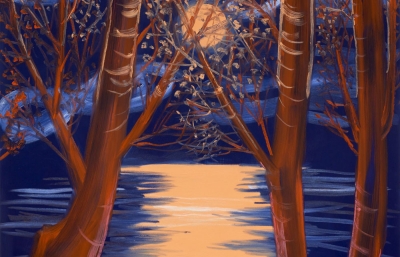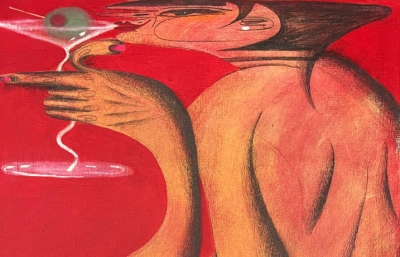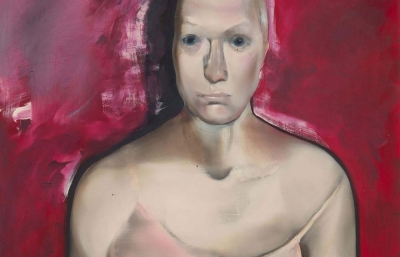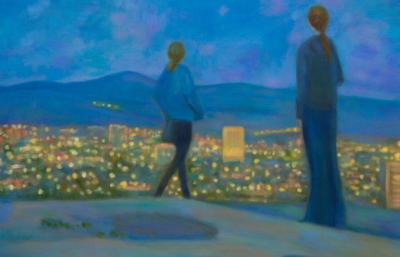Anna Weyant
Welcome to the Dollhouse
Interview and portrait by Sasha Bogojev
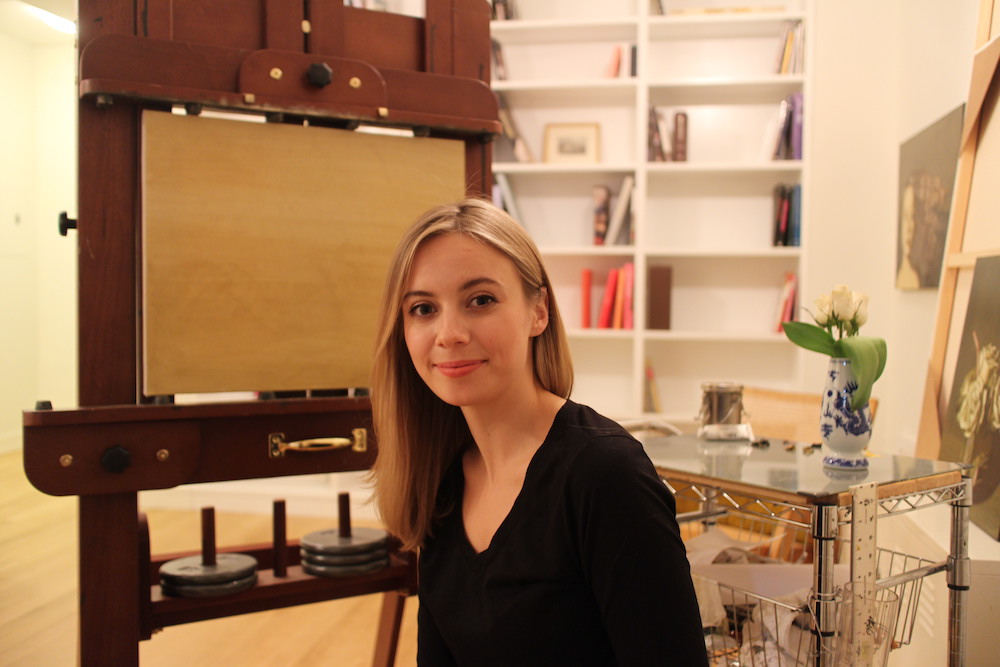
Back in January, while in NYC, when Juxtapoz co-presented ME: An Exhibition of Contemporary Self-Portraiture with Sugarlift, I visited Anna Weyant's studio on the Upper West Side. I felt energized, dodging crowds as I biked through Central Park on one of those sunny New York winter days. Upon my arrival, Anna welcomed me into her apartment and studio, and it immediately felt like a peaceful, intimate respite from the bob and weave outside.
A faceless doll silently held court in a living room walled with bookshelves filled with art titles. The comfortable space that doubles as her studio is populated with a few finished paintings that stamp the room with her intuitive, knowing presence. The characters and objects are muted in a subdued liquid chartreuse, embellished with unexpected twists. Evoking the works of Dutch masters, especially in still life compositions, the slightly sinister scenes are dominated by young female characters who seem in on the joke and very aware of life's irony.
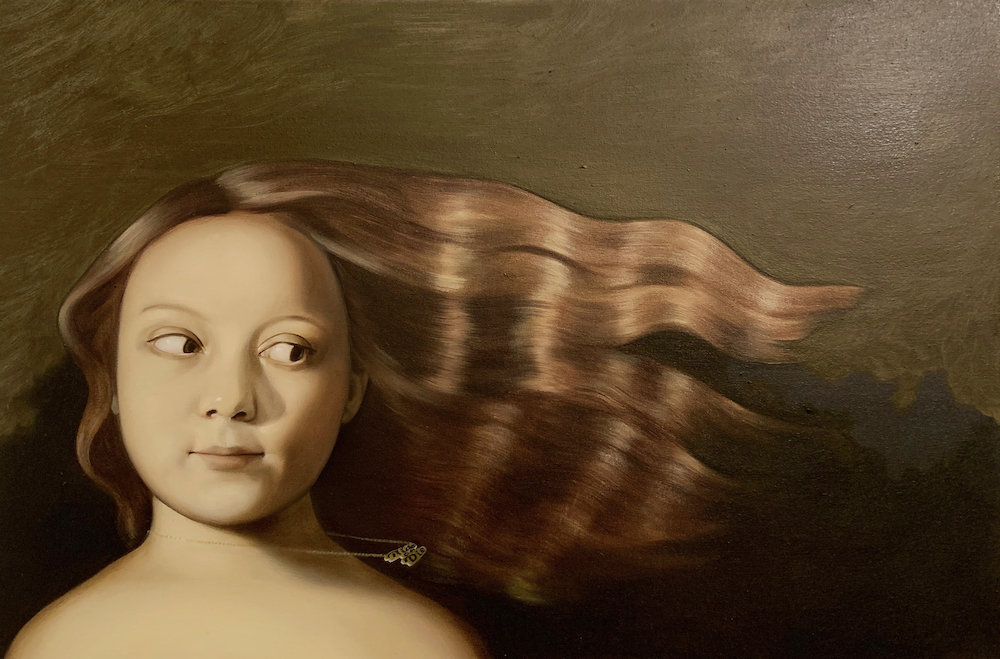
Sasha Bogojev: Let's start with a proper introduction—who are the women in your work? She’s not one in particular, is she?
Anna Weyant: It's not one girl. It's a few different girls. I have three or four friends who I paint regularly, and I switch, and sometimes they morph into each other. It doesn't start out as one girl but it usually turns into this very similar-looking face. There is one self-portrait I'm working on for a group show this summer, although it doesn't really look like me.
Do you purposely modify them, and how does that work?
I think there are features that I'm attracted to in a painting. I like a really round figure, something not bulbous, but round.
Any idea why you have that preference?
It probably starts with dolls. I worked on a show which followed these mischievous dolls and they were based on Madeline dolls. I don’t know if you are familiar with the Madeline children’s books? They’re bleak and dark, and set in France in an orphanage. Anyway, I had the dolls growing up, and they have these very round, big faces that I just loved.
Describe how they were mischievous.
It starts off with something just not right. It's about this girl who has her appendix taken out. She doesn't have parents. It's just sad, and I was thinking, what if these dolls grew up a little bit, and yeah, something just wasn’t right...

That is a curious premise. Did you literally depict the mischief or do you approach it in a more subtle sense?
I think subtlety. I'm into dark, dark humor. There's something amazing to me about tragicomic narratives. I think they have sad elements, but I don't want the paintings to be totally sad. This one I'm working on, with the ribbon, for example, I was thinking of as this person who's just lost a writing competition and received a participant award. They’re sort of semi-sympathetic, almost pathetic, but very endearing.
Sympathetic with the accent on pathetic. Like a bright side of a dark moment.
Totally. Or something so cringey that you have to laugh. It's so uncomfortable, but you just have to laugh.
How do you prepare the work? Does it come from photographs?
They sometimes come from photographs. It'll usually start with just an idea, something in my head. I will sketch it out in my head, and then sketch it out a few different ways on paper, and then I'll either set it up to photograph, or set it up to paint as a still life.
Ideally, I would have models in here to work from all the time, but I like to work alone. So sometimes it'll start as a photograph, and then I'll end up painting in front of a mirror, and then it works a little bit.
The girls look young, though you said the images are based on your friends. Do you purposely make them look younger?
Tweens and being in between childhood and adulthood is definitely a period of time in my life and other people's lives that I'm totally fascinated with and hung up on. It's a traumatic, dramatic, devastating, and hilarious time that I go back to constantly. So I'm naturally interested in observing that time in others.
The images have a very timeless quality as if they are from the present, or could also be almost medieval. Is that something you purposely conceive?
I like it when there's something that's not quite right in the image, something that doesn't fit, like one girl has a Ride or Die necklace on, and it's for horseback riding. But it's actually a biker phrase. So sometimes I have fun playing with the “Instagram meets old painting” type of clash.
Speaking of horseback riding, is that something you're connected with? Because a few pieces have references.
Personally I don't ride, but I've been lately interested in that culture. The idea of these young women riding is a total stereotype. Like Charlie and the Chocolate Factory, the girl who says “Daddy, I want another pony.” It's so fucked up and really fabulous. It's so much its own culture, too. I never rode, but grew up adjacent to it.

What's an emotion that you hope to elicit from the viewer?
I definitely have a complicated relationship with these girls who are non-existent, but I spend most of my time with them, so they've certainly become real. I would love for my audience to share a relationship with this pathetic and sympathetic character. I think there's humor in that, and I hope people can feel it. Humor is so important to me as a way of healing and just living through bad things.
Is feedback ever unexpected, or maybe amusing, or even a bit disappointing?
Yeah, probably a bit of all of that. Everyone has a different idea. I am outwardly a little bubbly, and someone I was just speaking to, who had seen the work before they met me, was having difficulty connecting the two—who I am and what the work is.
I can understand, now that I'm getting to know you. When I first saw a couple of your works, they felt ultra-feminine, like cover illustrations for books that girls would read when I was a kid. Yet, it felt like the packaging was right, but the content had more to say. Do you play with those stereotypical images on purpose?
I look at a lot of children's books. You would know this because you have a five-year-old, but sometimes there's a dirty joke in a kid's movie that the parents get that the kids don't get. That's just fascinating. There's so many young girls' books that can mean so much more than maybe they do on the surface level. It could be an image which is totally unaware of sexuality, for example.
How do you approach sexuality in your work, in light of these innocent looking images?
I like to skirt around it. This particular series of work maybe isn't the best example, but I did some horses for NADA, paintings of horses, and girls on horses, and in one of them, the tail covered the girl's boobs. I mean, she didn't really have boobs, which is also something I love, because dolls don't really have boobs—other than Barbie!
These dolls are definitely a source of inspiration for you! Did you play with dolls a lot when you were a kid?
I did, and for probably way too long!
For me, they appear like porcelain dolls, and I guess this color palette makes them seem almost inanimate. They're usually posed in a static position. You are intent on achieving this porcelain feeling, aren’t you?
Totally. I was always self-conscious about them being really stiff and frontal, but I thought I'd run with it. It's honestly probably a failure to be able to paint any other way, and it just happens. But I feel personally it has a very distinct quality, and I am flattered by that reference.
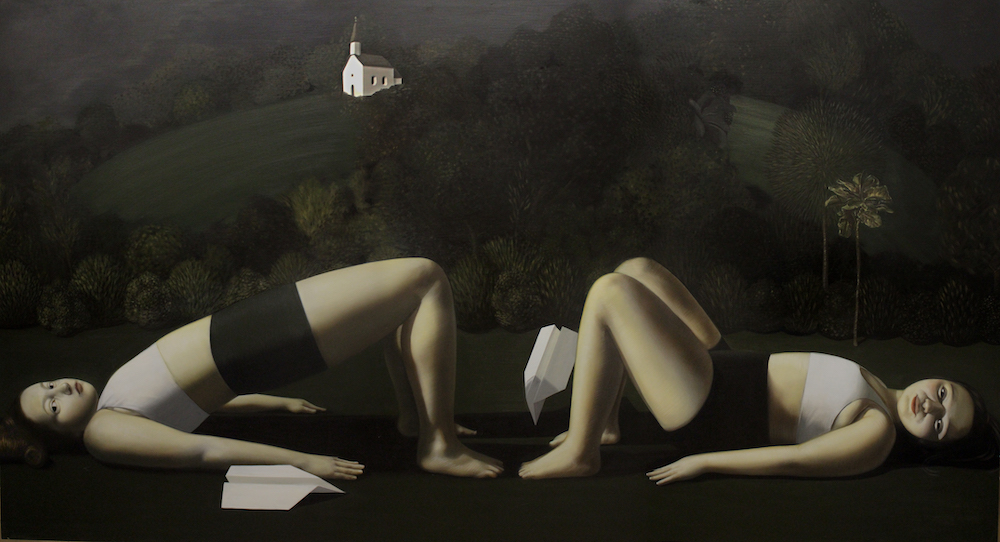
Have you thought about turning them into porcelain sculptures?
Actually, I did dabble in sculpture while I was at school, just to explore form. I used to sometimes sculpt the scenes I would make, but it was hopeless. They fell apart.
You're very consistent in your colors, as well. When did this develop, and was it purposeful? Or did you run out of other colors?
Yeah, I only have three colors left [laughs]. No, I've tried to switch it up a little bit, but I always end up going back to these. I think it's just a palette I'm really attracted to, and there's something disgusting and really beautiful about dark, dark greens and dark yellows.
What's your educational background, and what are your influences?
I grew up in Calgary, Alberta, and went to school there; actually, these colors were the colors of my uniform there. It's just always in my head, I guess. And then I graduated high school and moved to Rhode Island to study at Rhode Island School of Design, where I studied painting. I really didn't know a lot about art or art history until I went there, and so I was introduced to a bunch of artists.
The first John Currin painting I saw was at a show called She at Brown University. It was probably 2014, and I was just, like, "This is what I want to do." It was hilarious. It was this busty woman standing behind this guy in his shadow, and it was so off-putting and so amazing.
So you went to school without having any knowledge about artwork. How, then, did you decide to even go study art?
I don't know. I didn't really know what I was getting into. I guess I was interested in art a little bit. I did a pre-college summer program at the Art Institute of Chicago just for fun. It was just a summer camp, basically, and I saw Valdez and Grant Wood and really loved those. I thought I'd just give it a try. Yeah, it sounds crazy.
And you’ve stuck with art ever since?
I wavered a little bit while I was there, but I had this amazing teacher my last year named Kevin Zucker. He’s a painter and he was just so supportive and encouraging about whatever I wanted to do because I wasn't painting like this at all while I was there.
What did your work look like back then?
It was definitely more colorful and more chunky, and it was probably more in-style. It's hard to show people constantly and get critiqued on it, so it was trying to maybe fit in a bit more.

Apart from that one piece by Currin, do you have an idea of anything else that influenced your change in style?
That had the biggest impact, but I think just being alone and knowing that whatever I painted, I was going to put under my bed and feel no pressure. I moved here and I was working for another painter as her studio assistant. Then I was just painting at night in my room. I could just do whatever I wanted and there was no consequence, which totally changed the game.
That's a perfect way to get better at something. When and how did you start sharing and showing your work?
The artist who I worked for is a good friend, and she introduced me to her dealer, who now represents me. Then I started posting my work on Instagram and having more people see it.
Did you get immediate traction when you started posting it?
Not really, but it was encouraging to have friends be involved. I have a lot of friends who are painters in the city, and I value being able to talk to them about it.
Aside from your friends, what else influences you artistically?
I look at a lot of old Dutch painters, seventeenth-century Dutch painters for color palettes. Also, I’m a big fan of Lisa Yuskavage. And those are dolls, too, that she used at one point to paint from. And Will Cotton. I love the idea of having a world that's just specific to an artist.
Since you reference seventeenth-century Dutch painters, what's the concept behind your still life images?
I approach it in two ways. One is a way to practice from life, so I'll set that up and paint from it for as long as the flowers are alive, which is a good way to practice. One part of my series is the idea that this girl is competing in a contest, and loses or gets a participant award, and then she sabotages the winner's flowers. That makes sense in a goofy way. But I like still lifes as a complement to figures. Figuration is where my heart is.
So, the figures are the main element, and the accessories on the side connect the narrative. Are all the works united in that they follow the same story?
I think so, in the sense that they inhabit the same universe and I mostly paint young women who maybe live in that same world. I haven't done a story that's followable to anyone but me. The narrative is usually pretty abstract, but I have been thinking about that for the future.
I'd be curious to see that. What are your other aspirations for the future?
I'm beginning to work on a show that’s planned for London in the fall. And I'm focusing it around an event with these people. It's going to be a garden party where everything's going wrong. So it won't be a story, but it'll be an event.
Four Weddings and a Funeral type of thing?
Yeah. Like that, totally.
@annaweyant

